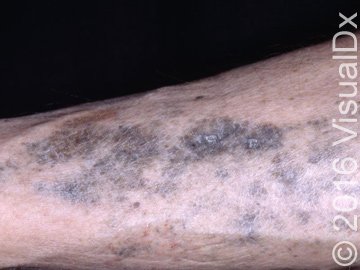
Differential Diagnosis
- Melasma
- Minocycline drug-induced pigmentation
- Addison disease
- Ashy dermatosis
Diagnosis
The patient has drug-induced pigmentation caused by minocycline.
Discussion
Drug-induced pigmentation caused by minocycline may affect the skin, mucosal surfaces, teeth, tongue, sclera, bone, heart, thyroid, and other locations. Minocycline is a tetracycline-derived antibiotic with various uses, most notably as a second-line treatment for acne vulgaris. Hyperpigmentation may follow ingestion of 100 to 200 mg/d for 1 to 3 years, and incidence rates vary from 2.4% to 14.8%. However, some studies have demonstrated the development of hyperpigmentation after small doses and short courses of minocycline. Children younger than 9 years of age should not be given medications from the tetracycline family of antibiotics.
The incidence seems highest in patients with conditions such as atopic dermatitis, acne vulgaris, rheumatoid arthritis, pemphigoid, and pemphigus. Drug-induced pigmentation caused by minocycline may affect the skin, mucosal surfaces, teeth, tongue, sclera, bone, heart, thyroid, and other locations. Four types of hyperpigmentation have been described. Each type varies in distribution and histology.
- Type I: Areas of facial inflammation, scars, and trauma
- Type II: Well-circumscribed patches on the arms and legs, or generalized discoloration away from areas of inflammation
- Type III: Muddy-brown discoloration of sun-exposed areas
- Type IV: Areas of scar tissue on the trunk
Acknowledgment: Image courtesy of Logical Images, Inc. (www.VisualDx.com/JUCM).
